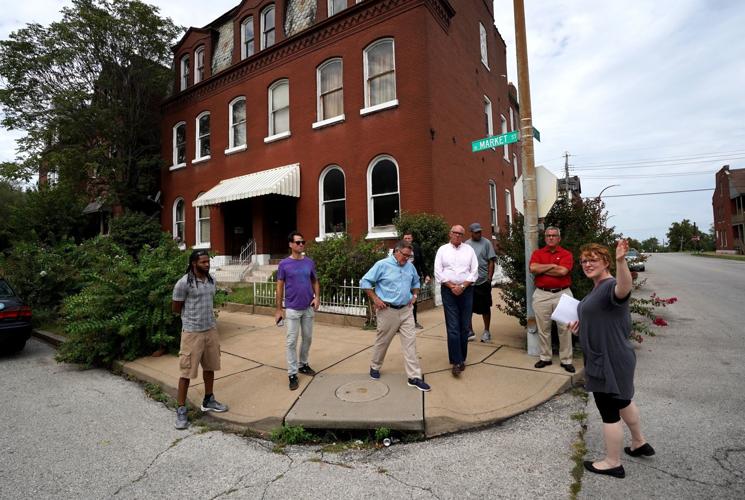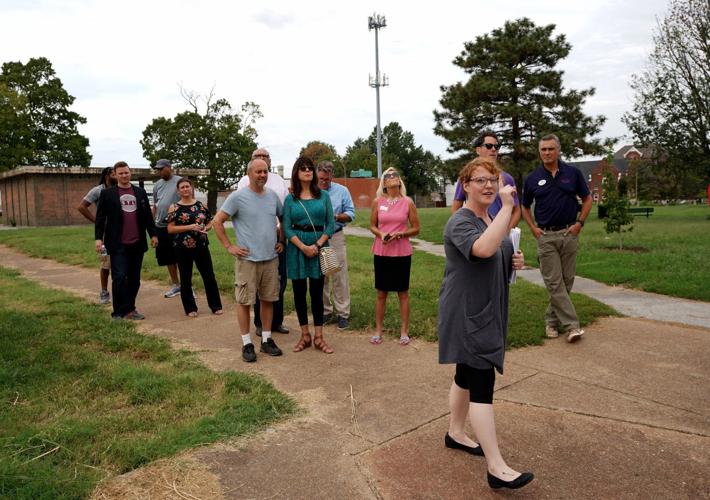There was a gaggle of real estate investors and agents, a title company worker or two and a banker who strolled Friday past the historic red brick houses that define the ├█č┐┤½├Į Place neighborhood.
It wasnŌĆÖt a big group. But for this north ├█č┐┤½├Į neighborhood, the dozen or so real estate professionals eyeing the grand architecture that happens to be on the wrong side of Delmar Boulevard for many investors could be a sign of things to come.
Just a few blocks to the south, earth is moving in preparation for a $1.7 billion investment in a federal intelligence agency expected to house some 3,000-plus workers. The National Geospatial-Intelligence Agency has made clear it sees collaboration with the private sector as key to its future, and private firms are expected to set up shop around its periphery.
People are also reading…
Some neighborhoods may be beyond saving; others need help now.┬Ā┬Ā
Investors who have largely ignored north ├█č┐┤½├Į, where many stately homes built in the late 1800s still stand, could help to fill in the vacant lots and crumbling structures scattered throughout many blocks.
ŌĆ£WhereŌĆÖs the next frontier? ThatŌĆÖs here,ŌĆØ said Brian Elsesser, a Realtor with Re/Max Results and an adjunct history professor who organized the small tour to spur some interest in the neighborhood near the NGA, which wonŌĆÖt open for another four years.
The narrow ├█č┐┤½├Į Place Park stretches through the neighborhood, crossing ├█č┐┤½├Į Avenue and its collection of mansions that are still a reminder of the time when it was known as MillionaireŌĆÖs Row. ItŌĆÖs two miles from downtown and the jobs there. Though itŌĆÖs still four or more years until it opens, it will be right in the NGAŌĆÖs backyard if the project is ultimately built.
Business owners and managers around the nationŌĆÖs three current NGA facilities say federal workers make for excellent customers.
ŌĆ£WeŌĆÖre down here trying to put eyes on the area,ŌĆØ said Markus Patton, a real estate investor who said he wanted to get a look at a neighborhood he hasnŌĆÖt considered much before. ŌĆ£If you donŌĆÖt do things like this, it might take 20 to 30 years for this area to get development rather than five or 10.ŌĆØ
Returns could be higher in neighborhoods north of downtown, where values have slumped to extremely low levels, sometimes only a few thousand dollars.
ŌĆ£With home inventories so low around the region it makes sense to look at undervalued neighborhoods like this one with potential,ŌĆØ said Dallas Deschatres, another real estate investor and agent who went on the tour.
The issue for many investors may be the perceived values of properties and appraisals that rely on comparable sales ŌĆö for which there can be few to none. Mortgage numbers for areas in north ├█č┐┤½├Į show they made up just 4 percent of the nearly 3,900 mortgages issued in the city last year.
The lack of private lending north of Delmar Boulevard is a major obstacle to the city's vacancy-fighting efforts.┬Ā
ŌĆ£The eternal problem is the appraisal,ŌĆØ said Simone Taffa of real estate firm Cortona Properties, which often works in the rebounding Forest Park Southeast neighborhood.
Taffa said appraisers often donŌĆÖt consider properties on opposite sides of Delmar Boulevard comparable sales, even if they are nearby. ŌĆ£Even if I have a buyer who is willing to pay top dollarŌĆØ banks donŌĆÖt lend above what the appraisal says the property is worth, he said.
The banker in the group, Marty McCabe of Bank of Springfield, said that, for investors, ŌĆ£thereŌĆÖs safety in numbers.ŌĆØ
ŌĆ£You need a lot of focus here,ŌĆØ he said. ŌĆ£You canŌĆÖt just have one person come in and do a large-scale project.ŌĆØ












